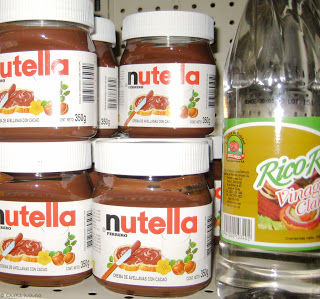I am not enthusiastic about shopping. Except shopping for postmodern furniture, Eileen Fisher bedding, Hanro underwear or Ecco shoes. Which means, I rarely actually shop – as in ‘to purchase’. Window shopping has it’s drawbacks also. It usually involves walking long distances on hard surfaces, inducing not only backaches but requiring frequent high-calory pit-stops at pastry shops. Perish the thought.
Shopping in Costa Rica has its own rewards and challenges. Most everything needed is available in either local retail stores, supermarkets or food stalls in our Mercado Central and Friday Feria del Agricultor, the Farmer’s market. Or at the roadside, where we got these splendid bell peppers.
You can buy lots of fruits and vegetables on your way to the store. Farmers or householders set up a display of their homegrown seasonal produce at their gate and you just pick and choose. But shopping in a ‘new’ country, in an utterly alien environment, can be quite disorienting, not to mention time-consuming. As a veteran buyer in your home country, you recognize and respond to visual cues, which allow you to sprint through the aisles, reaching for familiar packages without actually looking at them. Try that at the CoopeAtenas – I dare you!
 Flaxseed powder, Yuca flour (Cassava or manioc root, not to be confused with yucca shrubs) and isoflavone enriched soy protein flour are undoubtedly very healthy, but not a naturally occurring staple in your average gringo kitchen. Few products and brand names are easily recognizable on the store shelves and the overall organization of products throughout the store appears puzzling.
Flaxseed powder, Yuca flour (Cassava or manioc root, not to be confused with yucca shrubs) and isoflavone enriched soy protein flour are undoubtedly very healthy, but not a naturally occurring staple in your average gringo kitchen. Few products and brand names are easily recognizable on the store shelves and the overall organization of products throughout the store appears puzzling. Not that this disorientation is new to me. When I arrived in the USA thirty odd years ago, I was a whole lot more fluent in Shakespeare than shopping. In my early days of cultural assimilation in Fort Worth, Texas, I watched soap operas with TV commercials geared toward the homemaker. Among other vital information, I learned that in America, one can purchase cans containing ready-to-use cake frosting. So, when I saw a can with the picture of a woman decorating a cake in my local Safeway supermarket, I bought it. It turned out to be Crisco. ‘Crisco will do you proud every time’, remember that Loretta Lynne commercial? Where I came from, you made your own frosting and baked with butter.
Shopping was very confusing to me then. I hardly knew any of the English terminology describing articles of clothing, their styles, cut or sizes. Nor had I any idea how to address kitchen gadgets properly, or name the working parts of automobiles or identify furniture. I would’ve looked around for an overgrown male child, had someone mentioned a tallboy or, more likely, a highboy. Even supermarkets themselves were alien territory for me. I had lived the previous five years as a student on a spaghetti-no-meatballs budget in a small university town, rich in medieval architecture and cobblestoned pavements, where our focus was more strongly directed toward scholarly achievements and the quality of beer, than a special on a shrink wrapped package of 18 rolls of triple-layer toilet paper. But one product seems to accompany me throughout my life. Nutella, my own personal comfort food. Happily, also available at CoopeAtenas!
Were it not for the awkwardness of yet another foreign language to be conquered, my Old World upbringing with its small shops and the easy logic of the metric system, was actually a great preparation for living in Costa Rica, where both are the norm. I’ve fallen back into thinking in increments of one hundredth or one thousandth with ease. A kilo of maracuyas, two hundred grams of queso fresco. So simple.
Even our small town of Atenas has pretty much every possible specialty shop, from hardware to computer accessories to major appliances, baby booties or puppy toys, metallic stilettos or walking canes. However, any foreigner living in Costa Rica, who may be accustomed to particular products, be they North American, Asian or European, better watch that price tag carefully. The country’s import tax structure usually doubles the retail price for any product not manufactured in Central America.
It also means that, upon returning from a trip to the US, any returning expat has his or her suitcase crammed with everyday necessities at the best possible bargain price. Most of these favorites are readily available here, however, they’re significantly less costly, if pre-orded at online outlet shops in the US. One just has to take the place of origin for any given product into consideration –
or stick with fresh fruit, they’re the best ever!



Love the splendid peppers, but Crisco-frosted cupcakes are Halloween scary!
LikeLike